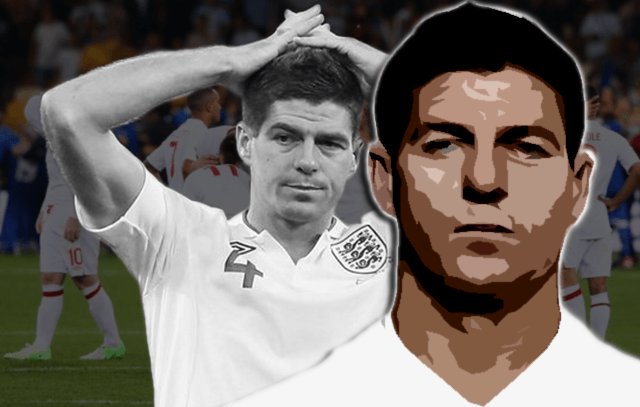Ryan Paton has a look at the now retired ex-England captain, his career with the Three Lions and just what went wrong throughout his international stint.
Ever since England qualified for the World Cup in Brazil it had been expected that the competition would be the final chapter in Steven Gerrard’s international career, and after a number of weeks deliberating following England’s early exit from yet another uninspiring performance in tournament football, Gerrard finally made it official on July the 21stwhen he announced his retirement from playing for his country. While it would be nice to pay tribute to the end of a glittering international career of one of the greatest talents the country has ever produced, the harsh reality is that the disappointment of Brazil was entirely appropriate in that it was in keeping with the rest of Gerrard’s international career, confirming how it will only be remembered for how forgettable it was.

Despite racking up a series of impressive statistics any boy growing up would dream of, achieving 114 international caps, 38 of which as captain, there is still something that seems so empty and unfulfilled about Gerrard’s England career. There is a myth that carries little weight suggesting the under achievement derives from within the player not being able to commit himself to the Three Lions of England in the same way he could to the Liver Bird of Liverpool, but this is easily disproved by passionate celebrations on the rare occasions things did actually go right, and the more familiar face of sinking disappointment he displayed when things often went wrong. In his statement, Gerrard said “I’ve given everything I could for England, every time I’ve gone out. What’s required when you put on an England shirt, is to give 100 per cent, fight and give your best and I’d like to think I’ve always given that.” Gerrard can rest assured that was something he did always give, and his pride in playing for his country should never be questioned. The blame for a disappointing international career does not lie with the player as it is not a case of Gerrard failing England, it is, as Martin Samuel states, England that ‘failed Steven Gerrard’ with a seemingly never-ending series of poor coaching selections that limited him into never being able to show much more than a tireless work ethic.
UPDATE: This article received an honourable mention in Goalden Times’ Word Ball 2015
In Gerrard, England had a man with an unmatched ability to single-handedly win football matches, and yet although the FA always seemed to offer the highest wages to their managers, they somehow never seemed to find the man with the tactical nous to perform what should have been an easy job in exploiting the exceptional ability within this supreme footballer. In the prime of England’s golden generation during the mid to late noughties, Gerrard was at the peak of his powers and was the clear stand out player. Captaining a team that did not possess the abundance of talent as England’s other domestic superpowers, Gerrard led Liverpool to a Champions League trophy in 2005, an FA Cup in 2006, another Champions League final in 2007, before mounting a serious Premier League title challenge in the 2008/09 season, always reaching double figures in the goal scoring department, and winning countless individual honours along the way. He is one of the most influential players to ever grace the game, with a fierce endeavour demonstrated in his approach to every game that demanded he be given the mantle of main man. Liverpool manager Rafael Benitez duly obliged and entrusted him with this responsibility by building a team around him, but this was something that was never offered to Gerrard at international level. Instead England chose to give this to nobody; incorporating tactics that did not really benefit any of their players, resulting in the formation of a team that always seemed out of ideas.
Gerrard is at his best when operating at the tip of a midfield triumvirate. In the Rafael Benitez era, this was in an attacking sense ahead of two tactically disciplined holding players, yet England never experimented with this form that would have allowed their best player to flourish. Instead, at the 2006 World Cup, manager Sven Goran-Eriksson switched between a conservative 4-4-2 and a 4-1-4-1 formation that suited neither of England’s main centre midfielders, Gerrard and Frank Lampard. During this period, every time the England squad regrouped, the age old debate of whether they can play together was renewed even though it was consistently answered with a resounding ‘no’. At club level these two played in the same position behind the striker occupying similar areas and looking to do similar things in possession of the ball. In the desire to build a balanced team, the question should have always been whether it was Lampard or Gerrard, and although Lampard is a quality player, Gerrard could exert an influence on a game Lampard never could. During Steve Mclaren’s ill-fated reign, Gerrard gave the England performance that most resembled those he consistently gave for Liverpool, galvanising the team to a 3-0 victory over Andorra, yet Mclaren mainly persisted with the horribly unbalanced 4-4-2, sometimes even moving Gerrard out of a central role altogether in order to fill the gap left by David Beckham in the right of midfield.
Things got worse for Gerrard under Fabio Capello, who bafflingly pushed him out into a wide left position for the first time in his career. A move that can only be explained in that he hoped Gerrard would cut in from the flank and score with his stronger right foot, but, from the variety of goals Gerrard has scored throughout his career, this is certainly not one you would say he excels at. Simply, Gerrard was England’s best player, so good that the team’s tactics should have been designed in order to maximise his talents, yet England never entrusted Gerrard with the mantle of main man as he always was at club level. Instead he was always asked to perform in a role unsuited to him, meaning that while he was as close as we’ll ever get to a footballing superhero for Liverpool, saving the day when it seemed everything was lost, for England he persistently turned out awkward performances as though he was in a nerdy, alter ego mode.
As with the rest of England’s golden generation, time started to have an effect on Steven Gerrard in the transition to the next decade. After a prolonged absence due to a serious groin injury and numerous managerial changes, Gerrard began to reinvent himself under Brendan Rodgers at Liverpool, who flipped the midfield triangle, enabling Gerrard to move to a less intense role further down the pitch, becoming a deep lying midfielder, guarded behind two high energy midfielders, whose rampant pressing created the necessary space for him to dictate the tempo of a game. Gerrard thrived within this system in the 2013/14 season, becoming a key component in Liverpool’s unexpected title challenge that lasted right until the final day of the season.
Even with this successful model in place at Liverpool, featuring a large English contingent such as Jordan Henderson, Daniel Sturridge, and Raheem Sterling, Fabio Capello’s successor Roy Hodgson decided yet again to ignore the idea of a balanced formation that suited the personnel he had available to him. In what must have been infuriating for Gerrard, Roy Hodgson instead adopted the 4-2-3-1 formation that would have suited his talents 6 years earlier, partnering Gerrard with Jordan Henderson in an unfamiliar double pivot, midfield two, in which it seems they were under orders to always remain side-by-side, unified as they moved up and down the pitch. This had been previously tested at club level against Aston Villa where Gerrard had one of his worst ever performances as a Liverpool player, yet Hodgson, like his predecessors, persisted with a system that didn’t suit Steven Gerrard, resulting in a disjointed midfield that simply didn’t work. For Liverpool, Henderson is Gerrard’s protector, and during the World Cup, Gerrard missed Henderson’s tireless pressurising that grants him the space to see a lot of the ball, leaving him horribly exposed.
And so, now it has all finally come to an end. Although it is sad that we’ll never see Steven Gerrard in an England shirt again, what is even more tragic is that the international career of one of the most explosive footballers to ever play the game goes out in the tamest of whimpers, playing a part in Luis Suarez’s goal that put England out, before finally donning the shirt in a drab 0-0 draw with Costa Rica which a lot of people wouldn’t have even watched due to a more interesting Uruguay vs Italy game taking place at the same time. The fact that Gary Neville was correct with his comment how England’s 2-1 defeat to Italy was their best display in competitive football for 15 years is shocking, and shows just how poor England have been for the duration of Gerrard’s international career. With Gerrard they had a real chance of overturning this, but shocking mismanagement meant that they never took full advantage of a player with ability rarely seen before in an English footballer. Of course football is a team game, and a player’s position should be dictated by what is best for the team, but I am certain that the team would have benefited from trying a formula to accommodate their best player in his most effective position.
Throughout history, there are certain special players who perfectly represent the playing style of their countries culture: Brazil’s easy-going, flamboyant, samba style was represented by Garrincha, Argentina’s mischief and raw passion embodied in Diego Maradona, Spain’s silky, pass and move, one-touch football symbolised by Xavi. Players who have this special combination of enormous footballing ability, and a connection with the essence of its culture’s football should have their team built around them, and in all the mentioned cases, coaches recognised and implemented this to huge degrees of success.
In Gerrard, England had their perfect English player. With a supreme level of technical ability to match the physical, robust style that could only have its roots in English football, Steven Gerrard was the perfect representation of the lions that feature in the emblem of the England shirt. Tough, fierce, aggressive, prowling the pitch with an intimidating swagger that struck fear into the hearts of opponents who knew that contained within Gerrard’s explosive right foot was the capability to swing any game in his team’s favour, Gerrard had the potential to become the fiercest lion in the pride. For Liverpool, this was realised as he has become the most influential player in the club’s history, however England’s run of poor managers implementing bad tactics somehow rendered him toothless, and rather than becoming the perfect lion, his international performances instead resembled that of a lion tamed.
Written by Ryan Paton.
- Can strange times inspire Liverpool dominance? - July 2, 2020
- Sympathy for Steven Gerrard: A Lion Tamed - September 4, 2014
- Commercialisation, PR stunts & bullying. Are Barcelona still ‘more than a club’? - August 25, 2014



























































